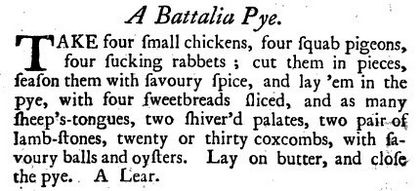Battalia pie facts for kids
A battalia pie was a large and fancy meat pie popular in English cuisine during the 1600s and 1700s. It was often filled with many small, special pieces of meat, sometimes called beatilles. These pieces were usually from different parts of animals, like certain organs, and were cooked in a rich gravy flavored with spices and lemon.
People sometimes got confused because the word "battalia" sounded like "battle." Because of this, these pies were often shaped like castles with towers and crenellated (notched) edges, just like a real fortress!
What's in a Name?
A battalia pie got its name from the word beatilles. These were small, special ingredients, often from different parts of birds or other animals. For example, they could include things like certain glands or other less common meats. The word beatilles comes from the Latin word beatus, which means "blessed."
Even though the name sounds like "battle" (from the Italian word battaglia), the pie isn't actually named after a fight. However, because of this confusion, cooks often made battalia pies look like castles with battlements and towers. It was a fun way to decorate the pie!
Old Recipes for a Fancy Pie
Cookbooks from the 1600s and 1700s describe how to make these elaborate pies. They show that battalia pies were very complex and used many different ingredients.
One old recipe from 1658, found in a book called The Compleat Cook, tells us to use:
- Four small pigeons
- Pieces of ox palate (a part of the mouth)
- Lamb-stones (a type of meat)
- Veal sweet-breads (glands)
- Twenty cocks-combs (from chickens)
- Bottoms of artichokes
- Oysters
- Marrow from bones
All these ingredients were seasoned with spices like mace, nutmeg, and salt. They were then placed inside a "coffin" (which was the pie crust) made of fine pastry. Butter and a little water were added before baking. After baking, the pie was finished with a gravy made from meat juices, butter, and lemon.
Robert May's 1660 cookbook, The Accomplisht Cook, also has a recipe for a "Bisk or Batalia Pie." His version suggests using:
- Six small pigeons and six small chickens
- Ox palates
- Lamb-stones and veal sweet-breads
- Cocks-combs
- Artichoke bottoms
- Oysters
- Marrow
- Sometimes even pistachios or hard-boiled egg yolks!
The pastry for these pies was also very important. Some recipes called for hot butter mixed with flour, while others used cold butter and eggs for a stiffer dough.
A Fishy Battalia Pie?
Not all battalia pies were made with meat! In 1723, John Nott's book The Cooks and Confectioners Dictionary shared a recipe for a fish battalia pie. This pie was also shaped like a castle with towers. It featured:
- A large salmon head in the middle
- Other types of fish arranged in different sections
- Seafood like cockles, prawns, oysters, and periwinkles, all cooked in a rich sauce.
Eliza Smith's 1727 cookbook, The Compleat Housewife, described a battalia pie with:
- Small chickens
- Pigeons
- Sucking rabbets (young rabbits)
- Sweetbreads
- Sheep's tongues
- Lamb-stones
- Coxcombs
- Oysters and savory balls (small meatballs)
Her recipe was so popular that it was printed again in later cookbooks, even into the 1800s!
Modern Recreations
Even today, people sometimes recreate these historic battalia pies. For example, they were made at Naworth Castle in England in 2006 and at Westport House in Ireland in 2015. It's a way to bring a taste of history back to life!


